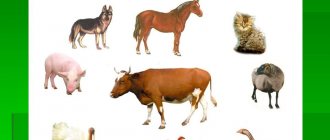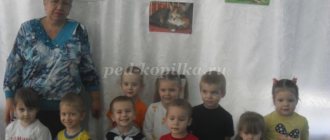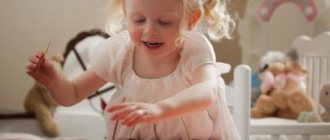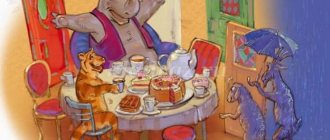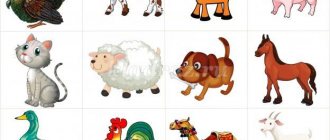Summary of an open lesson on speech development in the middle group “Wild and Domestic Animals”
Summary of an open lesson on speech development in the middle group “Wild and Domestic Animals”
Summary of an open lesson on speech development in the middle group “Wild and Domestic Animals”
Goal: Formation of cognitive and speech activity in children.
Tasks:
— consolidate children’s knowledge about the distinctive features of domestic and wild animals
;
- consolidate children’s knowledge in naming baby animals
;
— develop attention
, thinking and imagination, speech activity;
- cultivate a caring attitude towards nature and its inhabitants.
— activate children’s vocabulary, clarify the names of animals
. Where do they live?
- strengthen the ability to use in speech
nouns denoting
animals
.
— develop attention
, memory, ability to clearly pronounce words and sentences.
Educational:
— consolidation of knowledge about domestic and wild animals
.
- developing in children an idea of the diversity of the animal world
.
— develop
Creative skills.
Educational:
- cultivate interest in family
,
wild animals
.
Integration: Cognition, communication, socialization.
Preliminary work:
Looking at pictures of animals
, illustrations (
wild animals in the forest
,
pets in the village
,
animals with cubs
, a dog in a kennel, a squirrel in a hollow, a bear in a den, etc., reading stories (B. Zhidkov
“Evening”
,
“Brave Duckling”
,
“ Stray Cat”
, V. Bianki
“Mouse Peak”
, fairy tales (Russian folk tales
“The Wolf and the Seven Little Goats”
,
“Swan Geese”
,
“Crane and Heron”
,
“The Fox and the Hare”
, etc.,
“The Three Little Pigs”
S. V. Mikhalkova,
“The Ugly Duckling”
by H. H. Andersen, asking riddles Not an animal, not a bird, but afraid of everyone, catching flies and splashing into the water
(frog)
, etc., looking at
animal
.
Didactic games: “ Wild and domestic animals ”
.
"The Fourth Wheel"
.
Round dance games: “At the bear in the forest”
.
"We are walking through the forest"
.
Material:
Interactive whiteboard, pictures of wild and domestic animals
.
Contents of organized educational activities for children
1. Organizational moment
guests came to our lesson today
, let's say hello to them.
Music sounds ( animal )
.
- children, whose voices are these? (horse, cow, cat, elephant)
.
— how can you call them in one word? ( animals )
- what animals
?
( wild and domestic )
Today we will remember domestic
,
wild animals and their young
, where they live.
— Tell me, what is the difference between domestic animals and wild ones
?
(Place of residence, obtaining food)
.
(Children's answers)
.
Educator - Children today I invite you to the wonderful world of animals
. You are ready to go on a journey. Well, let's begin then!
Notes on the development of speech in the senior group with mental retardation Notes on the lesson “Pets”
GBDOU kindergarten No. 40
Summary of educational activities for speech development in the senior group with mental retardation
Lesson summary "Pets"
Compiled by: Krivtsova N.A.
Program content: -Consolidation of ideas about domestic animals and their cubs, their appearance, lifestyle and habits; -Clarification, expansion and activation of the dictionary on the topic “Pets”; -Improving the grammatical structure of speech (the use of nouns with the suffixes –onok-, -enok-; -Formation of skills in the formation of possessive adjectives;
-Exercise in using simple prepositions; -Development of auditory and visual attention, thinking, -Enrichment of children's vocabulary; -Formation of skills of cooperation, mutual understanding, goodwill, initiative, responsibility; - Fostering love and respect for pets; Equipment: Typesetting cloth, tape recorder, disc with recordings of the voices of domestic animals and their cubs, masks - caps, envelopes with cut-out pictures; subject pictures depicting domestic animals and their cubs, the painting “Animal Farm”. Preliminary work: - Conversation about the benefits of pets; -Learning the finger game “Cubs”; -Formation of concepts: “stable”, “pig sty”, “cowshed”, “sheepfold” in individual lessons. GCD move:
Organizational point: Relaxation exercise “Sunny Bunny”
Imagine that a sunbeam looks into your eyes. Close them. It ran further down the face. Gently stroke it with your palms: on the forehead, on the nose, on the mouth, on the cheeks, on the chin. Stroke gently so as not to frighten the head, neck, tummy, arms, legs. He climbed up the collar - pet him there too. He is not a mischievous person - he catches and caresses you, and you pet him and make friends with him (repeat 2-3 times).
Main part: The teacher invites the children to take a seat at the table, turns on the tape recorder (the recording of “Animal Voices” plays). -Where have we been? What did you hear there? (children answer) -List the animals whose voices we heard (children answer). -That's right, we heard the voices of a cow, horse, sheep, pig, dog, cat.
- Let us turn into domestic animals and imitate their voices.
(The teacher hands out animal masks, and the children imitate the voices of their animal, and then repeat it all together.) -I think you have already guessed that today we will talk about domestic animals, what they look like, what benefits they bring to humans, how people care for them. A conversation about pets based on the picture “Animal Farm”. -What can you call them all? -Why are they called pets? -Tell me what animals have? -What is the body covered with? —Where do pets live? -Why? -People look after them, build houses, take care of them, because they are useful. Game “Find the Animals” Development of visual attention, improvement of the grammatical structure of speech (use of simple prepositions). — Children, pay attention to the fact that all pets are very sad. Do you know why? -Because they lost their cubs.
Name the Baby Ball Game - Look around and help pets find their babies. -When you find your animal’s baby, take the figurine and go to your places. -Now tell me about where the cubs were hiding. -The calf was hiding behind a tree. -The lamb hid on the bridge. -The kid hid behind a bush. -The rabbit was sitting in a box. -Place the animal figurines and their babies on the table. Game “Collect a picture and tell about the animal using a mnemonic table” Development of visual gnosis-constructive praxis, thinking, fine motor skills of the hands. Expansion and clarification of the dictionary on the topic: “Pets” (children are offered an envelope with a cut picture, consisting of 5-6 parts). - Guys, take out the parts of the cut picture from the envelopes. You need to collect the whole picture. -And the pictures of pets on the board will be clues for you. -You completed the task correctly. Fold the cut pictures into envelopes. -And now we’ll rest and do some finger exercises.
Finger gymnastics “ Cubs” The cubs live in this house. Their mothers call and they immediately run. (naming the young domestic animals, they straighten the fingers on the hand, starting with the thumb) The foal is fast, the kitten is fluffy, the calf is vigorous, the puppy is playful, the kid is horned, all the guys ran away. (all fingers form a fist again)
Game “Who Lives Where?” Exercise in understanding the functions of suffixes in word formation. -We already know how a person cares for domestic animals: feeds them, builds dwellings (houses). Each dwelling has its own name. The horses live in the stable. Cows live in a barn. Pigs live in a pigsty. -Show me who lives where. -Who lives in a pigsty, etc. Physical exercise “Cat” The cat came out onto the ledge
The window opened (arms to the sides) and the cat came out onto the ledge. (imitation of the soft, graceful gait of a cat) The cat looked up, (throw back its head, look up) The cat looked down. (lower your head, look down) So you turned to the left, (turn your head to the left) She followed the flies with her gaze. (turn your head to the right, “follow” the fly with your gaze) She stretched, smiled (appropriate movements and facial expressions) and sat down on the ledge.
Result:
Educator: - Well done guys! Let's remember what we did today? What did you like most?
Summary of educational activities for speech development in the senior group “Wild Animals of Russia”
Program objectives: 1. Continue to introduce children to the wild animals of our country 2. Clarify the body parts of animals 3. Develop the ability to form complex adjectives 4. Develop the ability to name words with the same root 5. Practice naming an animal in combination with the word “many” 6. Cultivate careful attitude towards animals
Lesson progress:
Org.
moment. On the easel there are pictures of wild animals of Russia.
Educator: Guys, look at the pictures, who do you see? Children: Fox, wolf, bear, hare, moose, hedgehog, squirrel, wild boar, badger. Educator: That's right, guys, who is this? How can they all be called in one word? Children: Animals Educator: You are right, these are animals. Tell me where do these animals live? Children: In the forest Educator: So what are they like? Children: Wild Educator: Yes, these are wild animals. They live on the territory of our country. These are wild animals of Russia. Let's imitate them a little and perform articulatory gymnastics. Articulation gymnastics 1. “Squirrel” (the mouth is closed, the thin tongue pushes first in one direction, then the other, resting on the cheeks) 2. “Bunny” (the upper lip is pulled up so that the upper teeth are visible. The lower lip is pressed to the lower teeth. Hold for 10 seconds) Educator: Guys, you and I have different moods: both good and bad. Do you think it can change in animals? Children offer answer options Educator: Let's do the exercise Exercise “Animals” Using facial expressions they depict how the wolf is angry, the hare is shaking with fear, the squirrel is worried, the fox is happy. Educator: Do you like animals? Children: Yes Educator: Call them affectionately Game “Call them affectionately” (hedgehog - hedgehog, squirrel - squirrel, hare - bunny, etc.) Educator: Well done! I want to tell you a little about the hedgehog. A hedgehog is a wild animal that lives in the forest. It has prickly needles on its back. When he is afraid, he curls up into a ball. He is a predator and eats mice. It happens that people take a hedgehog home and feed it milk. Although the hedgehog is small, it walks noisily. Let's stomp along with the hedgehog. Finger gymnastics “Hedgehog” On a dry forest path - alternately hitting fist on fist and palm on palm.
Top - top - top - stomp your feet.
They tap their fists on the table one by one.
A gray hedgehog, covered in needles, walks and wanders along the paths.
They hit fist against fist and palm against palm.
Looking for berries and mushrooms for their son and daughter.
alternately connect the fingertips of both hands with the thumb Educator: Now, stand on your feet, imagine that we are wild animals Physical exercise “Wild Animals”
On a hot day, along a forest path, the animals went to a watering hole.
(Children walk in a circle, one after another)
A moose calf stomped behind the mother elk,
(They walk, stomping loudly)
A little fox crept behind the mother fox,
(They walk stealthily)
A hedgehog rolled behind the mother hedgehog,
(They move in a deep squat)
Behind the mother bear a bear cub was walking,
(They move in a deep squat)
The squirrel cubs were galloping after the mother squirrel,
(They were jumping on their toes, with their arms bent in front of the chest)
Behind the mother-hare were slanting hares,
(They were jumping, making “ears” from their palms)
The she-wolf led the wolf cubs.
(Walk on all fours)
All mothers and children want to get drunk.
(They walk on all fours) Educator: Excellent. Do you know that two words can be made into one? Shall we try? Children: Yes Game “Name a new word” (a bear has thick paws - a bear is thick-footed, a hare has long ears - a hare is long-eared, a wolf has sharp teeth - a wolf is sharp-toothed, etc.) Educator: Look at the pictures, what parts of the body does the wolf have? animals? 1 child:
the wolf has a head, muzzle, fangs, teeth, nose, eyes, ears, paws, tail, mouth, claws, torso, neck
2 child:
the bear has a head, muzzle, teeth, nose, eyes, ears, paws , tail, mouth, claws, torso, neck
Educator: We have wild animals depicted on our easel. A lot of them. Game “One - many” (one fox - many foxes, one hare - many hares, one hedgehog - many hedgehogs.) Educator: Well done, guys. Someone is knocking on our door. The postman enters.
Hello, guys, I was told to give you a parcel from the squirrel.
Delivers the parcel. Educator: Guys, what is there? They open the package, there are nuts and a note “Bon appetit! Sincerely, squirrel"
We recommend watching:
Notes for a lesson on speech development in the senior group: Special-purpose transport Notes for educational activities on the formation of a holistic picture of the world in children in the middle group with visual impairments. Di Summary of a lesson on speech development for children in the senior group of preschool educational institutions. Summary of a lesson on speech development in the senior group. Nosov "Gardeners"
Similar articles:
Summary of a lesson on speech development in the senior group. Compiling a descriptive story based on a painting
Summary of a lesson on speech development in the senior group. Reading works of fiction
Summary of a lesson on speech development in the senior group. Retelling of a work of art. Charushin "Sparrow"
Summary of a lesson on ecology in the senior group of kindergarten on the topic “Man and Nature”
Lesson on emotional development in the senior group
Summary of educational activities for speech development in the middle group on the topic “Pets and birds”
Summary of educational activities for speech development in the middle group on the topic “Pets and birds”
Author of the development
: Barinova V.P.,
Educational field:
cognitive development, speech development
Age:
children 4-5 years of age
Goal:
1. Enrich and systematize vocabulary .
2. Activate and consolidate speech on the topic “Pets and poultry” 3. Develop attention, thinking, memory, visual perception. Objectives:
1. Consolidate the general concept of “domestic animals and poultry”.
2. Development of children's speech activity. 3. Development of articulatory motor skills. 5. Development of general motor skills. Equipment:
Mail bag, toy house, model of a home yard, cardboard figures of baby birds and animals: duckling, chicken, puppy, foal, calf, kitten, cut and whole pictures depicting domestic animals and birds for each child, phonogram “Dance of the Little Ones” ducklings"
Lexical material: Words - objects:
invitation, cat, kitten, dog, puppy, cow, calf, horse, foal, duck, drake, duckling, rooster, hen, chick, birds, animals Words -
signs:
pets, pets birds.
Words - actions:
meow, bark, moo, neigh, quack, crow.
Progress of the lesson I. Organizational moment
Let's gather the children in a circle - I am your friend and you are my friend. Let's hold hands tightly and smile at each other.
Educator:
Guys, are you in a good mood?
(Children's answers) II. Main part Educator
: Friends, this mail bag and letter were brought to our group early in the morning.
Let's read it? (Yes) “Hello, guys! The postman Pechkin is writing to you. The fact is that I am sick and cannot deliver mail, so I ask you to help me. In my bag there are invitations to the birthday of a wonderful baby who is looking forward to guests for his holiday. And you will find out who this birthday boy is by guessing the riddle: Amazing child! Just out of diapers, he can swim and dive, like his own mother. (Duckling) Educator:
Well done, of course, it’s a duckling.
Well, guys, let’s help Pechkin and send out invitations? (Yes). So, the first invitation. Who should receive it? A yellow dandelion walks through the yard, A yellow dandelion pecks at the grains. (Chicken) Educator:
That's right, chicken, where do you think you should look for a chicken in the forest or on a home farm?
(On a farm, because it is a poultry) Children approach the chicken figurine and hand over an invitation letter and return to the teacher. Guys, show with your fingers how the chicken pecks the grains (with the fingers of one hand on the palm of the other). Well done! Educator:
Who is the second invitation addressed to?
The cow gives milk. Children with him are always healthy. The cow has a child - Nice, little... (Calf) Educator:
(Domestic) Children go and give a letter to the calf
Educator:
Tell me, is the calf a domestic animal or a wild one?
(Homemade). Children approach the calf figurine, hand over a letter of invitation and return to the teacher. Guys, let’s show how a calf butts with its horns” (put your index fingers near your head and shake it) You’re doing great. Educator:
But the third invitation awaits the Living Castle, He lay down across the door.
(Puppy) Educator:
Tell me, where will we look for the puppy?
(in the home yard, because the puppy is a pet) The children give the invitation letter to the puppy and return to the teacher. Guys, let's show how a puppy runs after its tail (run around itself) Isn't it fun? The fourth invitation, guess who is waiting? Mom is a horse, dad is a horse, Who is their child? Red, like fire, This is a foal. Educator:
Tell me, is a foal a domestic animal or a wild one?
(Home) Children approach the foal figurine, hand over a letter of invitation and return to the teacher. Guys, let’s show how a colt gallops” (jumps in place and flicks his tongue) What a great fellow you are. Educator:
Well, we will give the fifth invitation to the beast that plays with me: Doesn’t moo, doesn’t neigh, doesn’t bark, Attacks balls, Hides claws in its paws!
(Kitten) Educator:
Tell me, is a kitten a domestic animal or a wild one?
(Home) Children approach the kitten figurine, hand over an invitation letter and return to the teacher. Guys, how does a kitten drink milk” (the tongue is sometimes shown, then hidden) Educator:
Well done, guys, we handed out all the invitations that the duckling sent, but little children don’t go to visit on their own.
Who should they go with? (With mom (parents), etc.) Educator
: That's right, now let's sit down in our seats, there are cut pictures, when you put them together, you will see who our kids will go with.
Children:
sit at the tables and put the pictures together.
Teacher:
At the end of the work, asks everyone who is shown in the picture and whose mom or dad it is.
When he receives an answer, he puts a whole picture of the parent next to the cub’s figurine. Educator
: Guys, you are so great.
Now we will all go together to visit the duckling. (Each child takes a picture of a pet or its baby). Look, there is a house there, our birthday boy probably lives in it. The teacher and children approach the house, behind which figures of a duck and a duckling are displayed. Educator:
Guys, let's say hello.
(Children say hello). (Afterwards, those who have a picture of the named animals in their hands imitate their greeting) And now the drake, duck and duckling (quack-quack), and now the cow and calf (moo-moo), chicken (pee-pee-pee), chicken (ko-ko-ko), rooster (ku-ka-re-ku), foal and horse (i-go-go), cat, cat and kitten (meow-meow). Educator:
And now the duckling invites us to a fun dance.
Everyone is dancing to the tune “Dance of the Little Ducklings.” Educator:
Guys, we had fun at the duckling’s party.
Did you like it? (Children's answers) It's time for us to say goodbye, let's thank the duckling for the invitation and say goodbye. The children leave the house and sit down at the tables. III. Summary of the lesson Educator:
Guys, what do you think, did the duckling have a holiday?
(But why? (Children's answers) And if we had not sent out the invitations, would the holiday have taken place? What did you remember and like most? (Children's answers) Educator:
Let's remember which pets we gave the invitation to (Horse, cat, cow, dog, etc.) And which pet birds?
(duck, drake, chicken, rooster, etc.) Why are animals and birds called domestic? Children:
They live next to people. People care about them. And they bring benefits to people.
